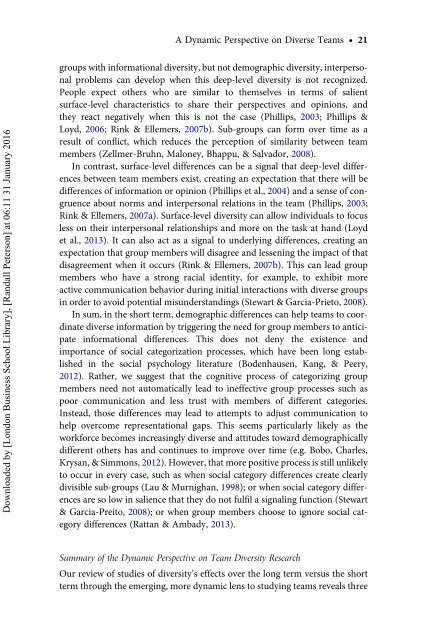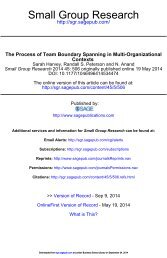A Dynamic Perspective on Diverse Teams: Moving From The Dual Process Model to A Dynamic Coordination-Based Model of Diverse Team Performance - Kannan Srikanth, Sarah Harvey & Randall Peterson
The existing literature on diverse teams suggests that diversity is both helpful to teams in making more information available and encouraging creativity and damaging to teams in reducing cohesion and information sharing. Thus the extant literature suggests that diversity within teams is a double-edged sword that leads to both positive and negative effects simultaneously.
The existing literature on diverse teams suggests that diversity is both helpful to teams in making more information available and encouraging creativity and
damaging to teams in reducing cohesion and information sharing. Thus the
extant literature suggests that diversity within teams is a double-edged sword
that leads to both positive and negative effects simultaneously.
Create successful ePaper yourself
Turn your PDF publications into a flip-book with our unique Google optimized e-Paper software.
A <str<strong>on</strong>g>Dynamic</str<strong>on</strong>g> <str<strong>on</strong>g>Perspective</str<strong>on</strong>g> <strong>on</strong> <strong>Diverse</strong> <strong><strong>Team</strong>s</strong> † 21<br />
Downloaded by [L<strong>on</strong>d<strong>on</strong> Business School Library], [<strong>Randall</strong> Peters<strong>on</strong>] at 06:11 31 January 2016<br />
groups with informati<strong>on</strong>al diversity, but not demographic diversity, interpers<strong>on</strong>al<br />
problems can develop when this deep-level diversity is not recognized.<br />
People expect others who are similar <strong>to</strong> themselves in terms <strong>of</strong> salient<br />
surface-level characteristics <strong>to</strong> share their perspectives and opini<strong>on</strong>s, and<br />
they react negatively when this is not the case (Phillips, 2003; Phillips &<br />
Loyd, 2006; Rink & Ellemers, 2007b). Sub-groups can form over time as a<br />
result <strong>of</strong> c<strong>on</strong>flict, which reduces the percepti<strong>on</strong> <strong>of</strong> similarity between team<br />
members (Zellmer-Bruhn, Mal<strong>on</strong>ey, Bhappu, & Salvador, 2008).<br />
In c<strong>on</strong>trast, surface-level differences can be a signal that deep-level differences<br />
between team members exist, creating an expectati<strong>on</strong> that there will be<br />
differences <strong>of</strong> informati<strong>on</strong> or opini<strong>on</strong> (Phillips et al., 2004) and a sense <strong>of</strong> c<strong>on</strong>gruence<br />
about norms and interpers<strong>on</strong>al relati<strong>on</strong>s in the team (Phillips, 2003;<br />
Rink & Ellemers, 2007a). Surface-level diversity can allow individuals <strong>to</strong> focus<br />
less <strong>on</strong> their interpers<strong>on</strong>al relati<strong>on</strong>ships and more <strong>on</strong> the task at hand (Loyd<br />
et al., 2013). It can also act as a signal <strong>to</strong> underlying differences, creating an<br />
expectati<strong>on</strong> that group members will disagree and lessening the impact <strong>of</strong> that<br />
disagreement when it occurs (Rink & Ellemers, 2007b). This can lead group<br />
members who have a str<strong>on</strong>g racial identity, for example, <strong>to</strong> exhibit more<br />
active communicati<strong>on</strong> behavior during initial interacti<strong>on</strong>s with diverse groups<br />
in order <strong>to</strong> avoid potential misunderstandings (Stewart & Garcia-Prie<strong>to</strong>, 2008).<br />
In sum, in the short term, demographic differences can help teams <strong>to</strong> coordinate<br />
diverse informati<strong>on</strong> by triggering the need for group members <strong>to</strong> anticipate<br />
informati<strong>on</strong>al differences. This does not deny the existence and<br />
importance <strong>of</strong> social categorizati<strong>on</strong> processes, which have been l<strong>on</strong>g established<br />
in the social psychology literature (Bodenhausen, Kang, & Peery,<br />
2012). Rather, we suggest that the cognitive process <strong>of</strong> categorizing group<br />
members need not au<strong>to</strong>matically lead <strong>to</strong> ineffective group processes such as<br />
poor communicati<strong>on</strong> and less trust with members <strong>of</strong> different categories.<br />
Instead, those differences may lead <strong>to</strong> attempts <strong>to</strong> adjust communicati<strong>on</strong> <strong>to</strong><br />
help overcome representati<strong>on</strong>al gaps. This seems particularly likely as the<br />
workforce becomes increasingly diverse and attitudes <strong>to</strong>ward demographically<br />
different others has and c<strong>on</strong>tinues <strong>to</strong> improve over time (e.g. Bobo, Charles,<br />
Krysan, & Simm<strong>on</strong>s, 2012). However, that more positive process is still unlikely<br />
<strong>to</strong> occur in every case, such as when social category differences create clearly<br />
divisible sub-groups (Lau & Murnighan, 1998); or when social category differences<br />
are so low in salience that they do not fulfil a signaling functi<strong>on</strong> (Stewart<br />
& Garcia-Prei<strong>to</strong>, 2008); or when group members choose <strong>to</strong> ignore social category<br />
differences (Rattan & Ambady, 2013).<br />
Summary <strong>of</strong> the <str<strong>on</strong>g>Dynamic</str<strong>on</strong>g> <str<strong>on</strong>g>Perspective</str<strong>on</strong>g> <strong>on</strong> <strong>Team</strong> Diversity Research<br />
Our review <strong>of</strong> studies <strong>of</strong> diversity’s effects over the l<strong>on</strong>g term versus the short<br />
term through the emerging, more dynamic lens <strong>to</strong> studying teams reveals three
















